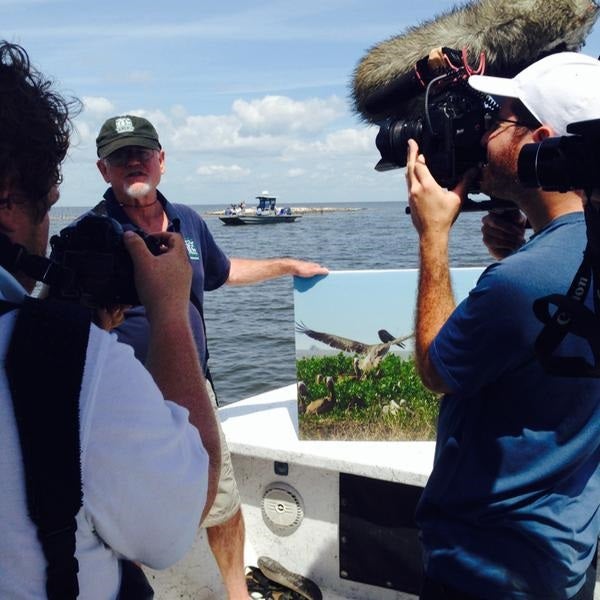Five Years Later: Gulf Oil Disaster’s Impacts to Habitat and Wildlife Still Evident
FOR IMMEDIATE RELEASE
Contact:
Emily Guidry Schatzel, National Wildlife Federation, 225.253.9781, schatzele@nwf.org
Jacques Hebert, National Audubon Society, 504.264.6849, jhebert@audubon.org
Elizabeth Van Cleve, Environmental Defense Fund, 202.553.2543, evancleve@edf.org
Five Years Later: Gulf Oil Disaster’s Impacts to Habitat and Wildlife Still Evident
Leading Conservation Groups Highlight BP Spill’s Ongoing Effects, Continued Need for Restoration
(New Orleans, LA—March 31, 2015) Five years after the Deepwater Horizon rig exploded, killing 11 men and spewing at least 3.19 million barrels of oil into the Gulf of Mexico, leading national and local conservation organizations working on Mississippi River Delta and Gulf Coast restoration – Environmental Defense Fund, National Audubon Society, National Wildlife Federation and Lake Pontchartrain Basin Foundation – released the following statement:
“Despite BP’s claims that the Gulf oil disaster and its ecological impacts are over, ongoing research and present-day observations in areas that were heavily oiled tell a different story.
“New independent scientific studies provide evidence that the full consequences of the spill to wildlife and habitats are still unfolding. From dolphins to sea turtles to birds, we still are seeing the real and lasting environmental impacts of one of the worst oil spills in our nation’s history.
“BP claims the nearly 134 million gallons of oil spilled into the Gulf has not negatively affected the ecosystem. But continued surveillance of areas like Barataria Bay, where thick oil coated vital wildlife habitat, including marshes and barrier islands, reveals lasting effects of the spill. Cat Island, a mangrove island that was heavily oiled, was once a lush, thriving rookery for brown pelicans and other birds, but today it is gray, lifeless and has nearly disappeared. Other coastal areas damaged by the spill are also still in need of repair.
“To this day, oil is still being found, most recently in the form of a 25,000-pound tar mat located on a Louisiana barrier island, near where 40,000 pounds of BP-oiled material was unearthed two years ago. It’s time for BP to put the publicity campaign aside, stop shirking responsibility and finally ‘make it right’ for the people, wildlife and habitats of the Gulf Coast.
“The oil disaster wreaked incomparable damage to an already-stressed Gulf Coast ecosystem. In Louisiana, the oil spill dealt another blow to an area ravaged by land loss – since the 1930s, Louisiana has lost nearly 1,900 square miles of land, or an area the size of Delaware. Nowhere is restoration more needed than the Mississippi River Delta, which is the cornerstone of a healthy Gulf ecosystem.
“Restoration solutions are within reach and plans are in place, but implementation of restoration plans cannot fully begin until BP accepts responsibility and pays its fines. Thanks to vehicles like Louisiana’s Coastal Master Plan and the historic RESTORE Act of 2012, which ensures that the Clean Water Act fines BP pays will be used for restoration, the Gulf Coast can make headway on real restoration projects that can make a difference. We have a once-in-a-lifetime opportunity to restore the health of our wetlands, revive Gulf Coast economies that depend on them, and make the Gulf Coast better than it was before the spill, but we must begin restoration now. The Gulf Coast – and the people, wildlife and jobs that depend on it – cannot wait any longer.”
Background:
Since the BP oil disaster five years ago, ongoing findings deliver truths omitted by BP’s ads: the oil disaster’s negative effects are increasingly clear, present and far from resolved.
A new infographic depicts ongoing impacts of the Gulf oil disaster five years later. And over the past year alone, new scientific research has surfaced:
- A 2014 study found evidence of a 1,250-square-mile area of oil contamination on the ocean floor around the Macondo wellhead in deep Gulf sediments.
- A new NOAA study found a large number of dead dolphins in heavily oiled places, including Barataria Bay, La.
- Recent studies estimate 800,000 birds died as a result of being exposed to BP oil.
- Modeling for a recent stock assessment projected that between 20,000 and 60,000 Kemp’s ridley sea turtles died in 2010 as a result of the spill.
- A 2014 study found concentrations of PAH (polycyclic aromatic hydrocarbon) – which can cause harmful effects in many birds, fish and wildlife – in Barataria and Terrebonne marshes, which may persist for decades.
- A 2012 study found that oiled marshes in Barataria Bay eroded at double the rate of non-oiled marshes.
###

David Muth of the National Wildlife Federation on a tour of Barataria Bay, La. March 31, 2015.